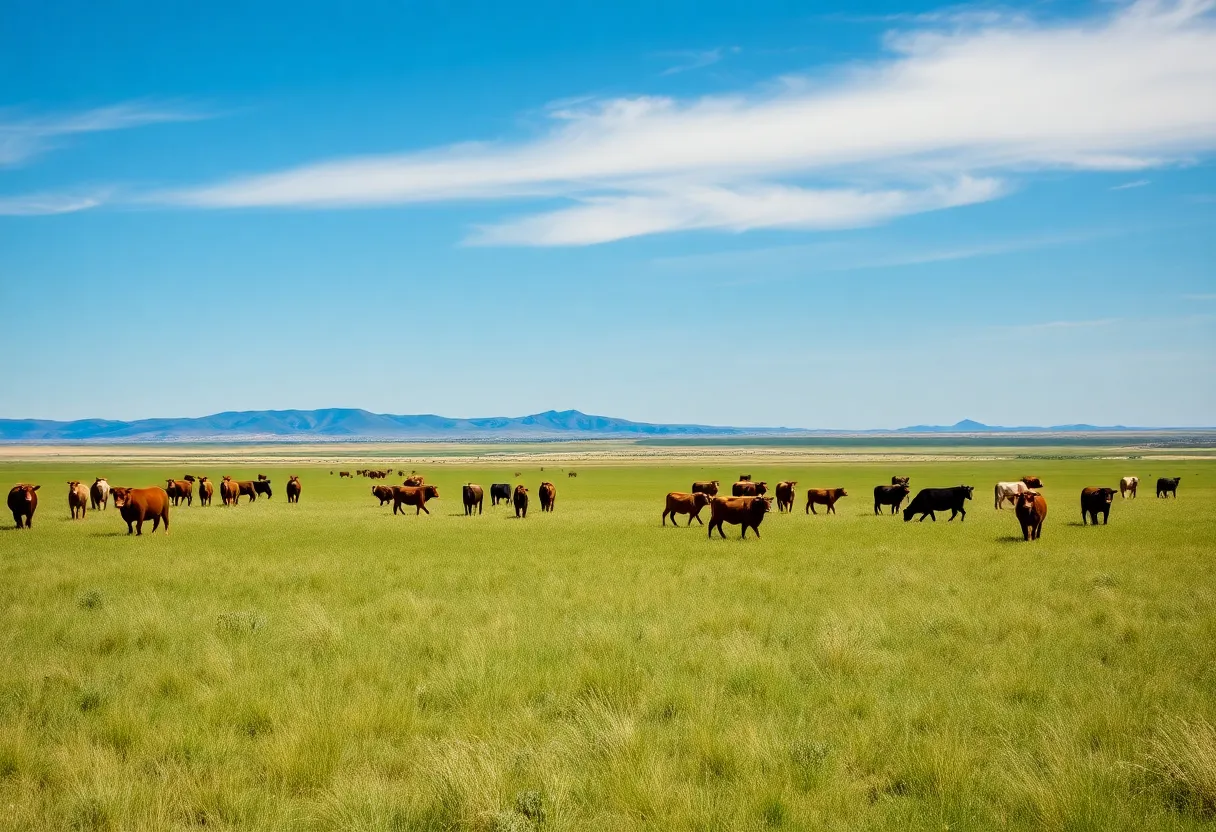Albuquerque, October 27, 2025
Cattle ranchers in New Mexico, especially around Albuquerque, are witnessing a significant rise in revenue due to record-high beef prices. This financial uplift, attributed to supply chain shortages, allows ranchers to offset rising operational costs while contributing vital support to the local economy. Despite the optimism, challenges such as drought and market volatility pose risks to sustainable growth. State agriculture leaders are advocating for diversification and sustainable practices to build resilience in the agriculture sector.
New Mexico’s Cattle Ranchers Experience Revenue Boost from Record Beef Prices
Albuquerque, NM – Record-high beef prices are delivering a critical financial lift to cattle ranchers across New Mexico, especially in the eastern plains surrounding the Albuquerque area.
Ranchers in this region, long challenged by fluctuating market conditions, are seeing substantial gains as beef prices reach all-time highs. This surge stems from ongoing supply chain shortages that have tightened the market and driven up values. For family-owned operations like Rio Bravo Farms, the impact has been immediate, with revenue climbing by 30% compared to previous periods. These elevated prices offer a vital buffer against the rising costs of feed and operations, which have squeezed margins for years.
The boost arrives at a pivotal moment for New Mexico’s agriculture sector. Cattle production remains a cornerstone of the state’s rural economy, supporting thousands of jobs and contributing significantly to local communities. In the eastern plains, where vast open ranges define the landscape, ranchers depend on healthy livestock markets to sustain their livelihoods. The current price rally has allowed many to reinvest in their herds, repair infrastructure, and cover debts accumulated during leaner times.
Underlying Causes of the Price Surge
Supply chain disruptions play a central role in the elevated beef prices. Factors such as labor shortages, transportation bottlenecks, and processing plant capacity constraints have limited the availability of beef products nationwide. These issues, lingering from recent global events, have created a mismatch between supply and demand. Consumers, facing higher retail prices, are indirectly fueling this trend, as packers prioritize premium cuts to meet restaurant and export needs.
In New Mexico, the effects are particularly pronounced due to the state’s focus on grass-fed and local beef production. Ranchers here benefit from shorter supply chains to regional markets, allowing quicker adaptation to price signals. Operations around Albuquerque, including those in nearby counties like Torrance and Valencia, report selling steers at premiums not seen in decades. This has translated into healthier cash flows, enabling some to expand grazing lands or upgrade equipment.
Challenges Looming on the Horizon
Despite the optimism, experts highlight potential risks that could undermine this progress. Drought conditions, increasingly common in the Southwest, threaten to reduce forage availability and water supplies essential for cattle health. New Mexico has already endured several dry years, forcing ranchers to purchase supplemental feed at inflated rates. If precipitation patterns fail to improve, herd sizes could shrink, reversing some of the revenue gains.
Additionally, the reliance on beef prices exposes the sector to volatility. Historical patterns show that high prices often precede corrections, as producers ramp up output in response. For smaller, family-run ranches, which dominate the eastern plains, this cyclical nature adds uncertainty. Many lack the financial reserves to weather downturns, making the current windfall a temporary rather than transformative relief.
Statewide Push for Sustainable Practices
To build resilience, state agriculture leaders are encouraging diversification into more sustainable methods. Recommendations include rotational grazing to preserve soil health, adoption of drought-resistant forage varieties, and integration of alternative income streams such as agritourism or value-added products like branded beef. These strategies aim to lessen dependence on commodity prices alone, fostering long-term viability in a changing climate.
Efforts are underway through state programs offering grants for water conservation and soil management. Ranchers at places like Rio Bravo Farms are exploring these options, blending traditional practices with modern techniques. The goal is to create operations that can endure environmental stresses while maintaining profitability. In the eastern plains, cooperative networks are forming to share resources and knowledge, amplifying the reach of these initiatives.
Broader Implications for New Mexico’s Economy
The cattle industry’s uptick reverberates through New Mexico’s economy. Auction houses, feed suppliers, and trucking firms in the Albuquerque vicinity are experiencing increased activity. Rural towns benefit from heightened spending on goods and services, providing a ripple effect that supports local businesses. This infusion of revenue helps stabilize communities often overlooked in urban-focused growth narratives.
However, the emphasis remains on preparation for future hurdles. With beef prices offering only a brief reprieve, proactive measures are essential. By addressing rising feed costs through efficiency gains and exploring new markets, ranchers can position themselves for sustained success. State leaders view this period as an opportunity to invest in innovations that secure the industry’s role in New Mexico’s agricultural heritage.
Overall, the record beef prices underscore the delicate balance in cattle ranching. While the 30% revenue increase at operations like Rio Bravo Farms signals hope, the interplay of supply dynamics and environmental factors demands vigilance. New Mexico’s ranchers, rooted in the eastern plains around Albuquerque, continue to adapt, ensuring their contributions to the state’s economy endure.
FAQ
What is causing the record-high beef prices in New Mexico?
Supply chain shortages are driving beef prices to all-time highs.
How much have revenues increased for ranchers like those at Rio Bravo Farms?
Ranchers like those at Rio Bravo Farms report 30% revenue increases.
Where are the primary beneficiaries of these prices located?
New Mexico’s cattle ranchers, particularly in the eastern plains around Albuquerque, are benefiting.
What risks are experts warning about for future yields?
Experts warn of potential droughts impacting future yields.
What are state agriculture leaders recommending to ranchers?
State agriculture leaders urge diversification into sustainable practices to ensure long-term viability.
Why is this considered a brief reprieve for family-owned operations?
This is a brief reprieve for family-owned operations facing rising feed costs.
Key Features Chart: New Mexico Cattle Ranching Boost
| Feature | Description | Impact |
|---|---|---|
| Record Beef Prices | All-time highs due to supply chain shortages | Financial lift for ranchers |
| Revenue Increase | 30% at operations like Rio Bravo Farms | Buffer against rising feed costs |
| Geographic Focus | Eastern plains around Albuquerque | Supports local family-owned operations |
| Potential Risks | Droughts impacting future yields | Threatens long-term sustainability |
| State Recommendations | Diversification into sustainable practices | Ensures long-term viability |
| Overall Assessment | Brief reprieve for the sector | Opportunity for proactive adaptation |





